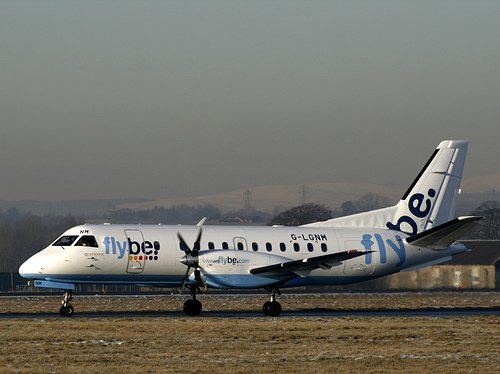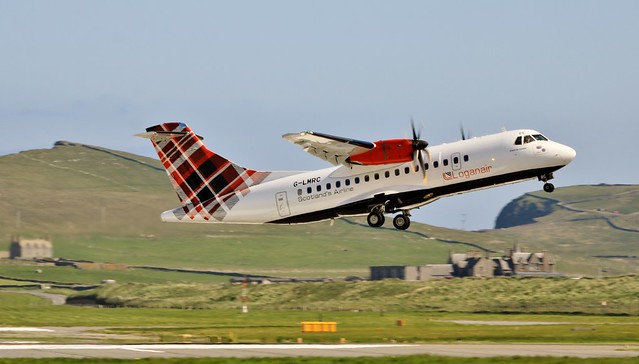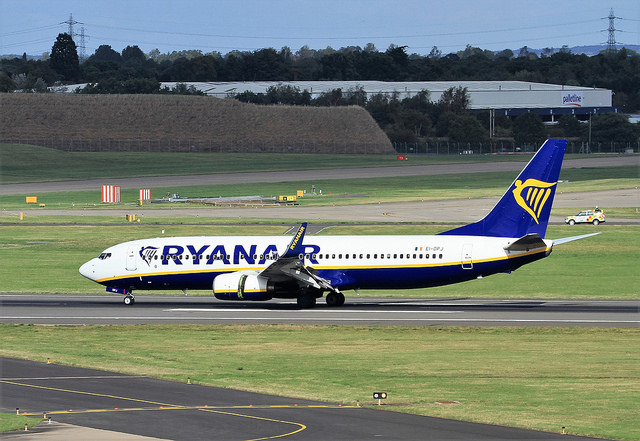Loganair SF34 near Aberdeen on Oct 3rd 2014, approach to stall in icing conditions
Last Update: September 10, 2015 / 17:08:06 GMT/Zulu time
Incident Facts
Date of incident
Oct 3, 2014
Classification
Report
Airline
Loganair
Flight number
BE-6772
Departure
Aberdeen, United Kingdom
Destination
Shetland Islands Sumburgh, United Kingdom
Aircraft Registration
G-LGNM
Aircraft Type
SAAB 340
ICAO Type Designator
SF34
The British AAIB released their final bulletin concluding the probable causes of the serious incident were:
G-LGNM probably encountered both severe icing conditions and mountain wave effect while climbing. The crew reduced the airspeed to VCLEAN+15, for optimum climb performance, but the propeller rpm and power were not increased to MCP. The co-pilot perceived that the command gradient between himself and the commander was too steep for him to feel comfortable advocating such a procedure, even though he believed it appropriate.
After levelling-off, airspeed initially increased before reducing back towards VCLEAN+15, a speed that was only intended for use when climbing out of icing conditions, and in combination with MCP. It was apparent that the aircraft’s performance was being impaired by ice and it would have been appropriate to set MCP, as well as disengage the autopilot.
Pre-stall buffet was experienced and the recovery was delayed until after the stall warner had activated. Not all the stall recovery vital actions were implemented, although control was regained before a wing drop developed, as had happened in previous Saab 340 stall events.
The manufacturer is reviewing the guidance in the AFM and AOM, relating to flying the Saab 340B in icing conditions, and the operator has updated its advice to crews on the same subject.
The AAIB analysed: "The conditions at FL130 were capable of supporting SLD greater than 0.05 mm (50 microns) in diameter which can lead to the formation of severe icing. Analysis by the manufacturer concluded that the aircraft was affected by a large increase in aerodynamic drag. This could have been due to ice or downdraughts or a combination of the two. Even if the downdraughts had been twice as great as the Met Office calculated, the increase in aerodynamic drag indicated that the aircraft had probably encountered severe icing conditions."
The AAIB analysed: "The OM, as extant at the time of the incident, also stated that a speed reduction to VCLEAN+15 may be used for flaps 0 climb to exit icing conditions, when above MSA. However, it did not link this to an increase in power to MCP and the setting of maximum propeller rpm. Nevertheless, the pilots were familiar with NOTAC 66/13, which recommended that, if the climb were continued, the initial actions should be to move the condition levers to the max position, set MCP according to the appropriate chart, select half bank and climb straight ahead at a speed not below VCLEAN+15. The commander did not set MCP when reducing the IAS below VCM because he thought that downdraughts were primarily responsible for the reduction in the rate of climb, not icing. Furthermore, he believed that propeller rpm only needed to be increased to aid the shedding of propeller ice if severe icing conditions had been identified. The co-pilot did not advocate the setting of MCP because he considered that the commander would not value such a suggestion. The manufacturer’s analysis determined that, if MCP had been set, the aircraft could have been climbed to FL170 and vacated icing conditions."
The AAIB analysed stall recovery:
The AOM stated that in (certified) ice conditions, buffeting might be experienced at an IAS up to 25% above the clean stall speed. This equated to 131 KIAS at G-LGNM’s weight. However, the aircraft apparently encountered severe icing, which placed it outside certified conditions, and a strong vibration (the pre-stall buffet) was noticed at 137 KIAS. The co‑pilot was not sure of the significance of the vibration, while the commander was attempting to use the autopilot to lower the nose and increase airspeed. The Emergency Checklist states that if there is any doubt about the source of an unusual vibration or buffeting, a stall recovery must be performed.
As the IAS decreased, a roll to the left was corrected by the autopilot. This reflected a previous investigation, concerning N306AE, which noted a similar rolling motion prior to the stall of that aircraft. The OM recommends a reduction in AOA in the event of an uncommanded roll movement. This appears in a section relating to ‘SLD Detection’.
Of note, the stall warning would have been set to a lower AOA if the ‘Ice Speed Function’ had been operational. If so, the warning would have operated at an IAS of about 140 KIAS, before the pre-stall buffet and the uncommanded roll.
When the stall warning activated and the autopilot dis-engaged (at 132 KIAS, with an AOA of 13º), the commander effected a recovery by pitching the nose down to accelerate the aircraft. However, he did not call ‘stall - max power’ and use all available power, as specified in the AOM.
The pilots’ previous stall training had commenced from an approach configuration, with a low power setting and with the propeller rpm already at max. The pilots had practised carrying out a stall recovery by advancing the power levers but not the condition levers.
This anomaly was highlighted during the investigation and has been addressed by the operator in a new training schedule (see Safety Actions later in this report).
The AAIB analysed: "No definitive explanation could be given for the illumination of the ice prot caution and the timer light as the airspeed increased. It was likely to have been caused by a discrepancy in one of the sensors in the de-ice boot system but, as it cleared when the abnormal checklist actions were taken, there is no evidence that it was a contributory factor in the incident."
Incident Facts
Date of incident
Oct 3, 2014
Classification
Report
Airline
Loganair
Flight number
BE-6772
Departure
Aberdeen, United Kingdom
Destination
Shetland Islands Sumburgh, United Kingdom
Aircraft Registration
G-LGNM
Aircraft Type
SAAB 340
ICAO Type Designator
SF34
This article is published under license from Avherald.com. © of text by Avherald.com.
Article source
You can read 2 more free articles without a subscription.
Subscribe now and continue reading without any limits!
Read unlimited articles and receive our daily update briefing. Gain better insights into what is happening in commercial aviation safety.
Send tip
Support AeroInside by sending a small tip amount.
Related articles
Loganair SF34 near Kirkwall on Sep 24th 2015, engine shut down in flight
A Loganair Saab 340B on behalf of Flybe, registration G-LGNM performing flight BE-6938 from Kirkwall,SC to Inverness,SC (UK) with 32 people on board,…
Loganair AT42 at Aberdeen on Aug 27th 2022, both engines show 0 torque in flight, multiple electrical failures
A Loganair Avions de Transport Regional ATR-42-500, registration G-LMRC performing flight LM-72 from Aberdeen,SC to Sumburgh,SC (UK), was climbing…
Logan AT42 near Aberdeen on Jul 23rd 2024, engine shut down in flight
A Loganair Avions de Transport Regional ATR-42-600, registration G-LMSA performing flight LM-436 from Sumburgh,SC to Glasgow,SC (UK), was enroute at…
Logan E145 at Manchester on Dec 5th 2024, lightning strike cracks windshield
A Loganair Embraer ERJ-145, registration G-SAJH performing flight LM-26 from Manchester,EN to Aberdeen,SC (UK), was climbing out of Manchester when…
Logan AT72 at Aberdeen on Sep 28th 2023, unusual odour on board
A Loganair Avions de Transport Regional ATR-72-212A, registration G-LMTD performing flight LM-78 from Aberdeen,SC to Shetland Islands,SC (UK), was…
Logan E145 enroute on Dec 20th 2022, indication fault
A Loganair Embraer ERJ-145, registration G-SAJI performing flight LM-45 from Aberdeen,SC to Bristol,EN (UK), was enroute at FL330 about 25nm…
Newest articles
Buffalo B732 at Goose Lake and Yellowknife on Oct 20th 2025, uncommanded nose gear extension and collapse
A Buffalo Airways Boeing 737-200, registration C-GTVO performing flight J0-202 from Goose Lake,NU to Yellowknife,NT (Canada) with 3 crew on board,…
Ryanair B738 at Cluj on Nov 3rd 2025, first officer incapacitated
A Ryanair Boeing 737-800, registration EI-DPJ performing flight FR-2682 from Milan Bergamo (Italy) to Cluj (Romania), was descending towards Cluj…
Subscribe today
Are you researching aviation incidents? Get access to AeroInside Insights, unlimited read access and receive the daily newsletter.
Pick your plan and subscribePartner

ELITE Simulation Solutions is a leading global provider of Flight Simulation Training Devices, IFR training software as well as flight controls and related services. Find out more.
SafetyScan Pro provides streamlined access to thousands of aviation accident reports. Tailored for your safety management efforts. Book your demo today
AeroInside Blog
Popular aircraft
Airbus A320Boeing 737-800
Boeing 737-800 MAX
Popular airlines
American AirlinesUnited
Delta
Air Canada
Lufthansa
British Airways








